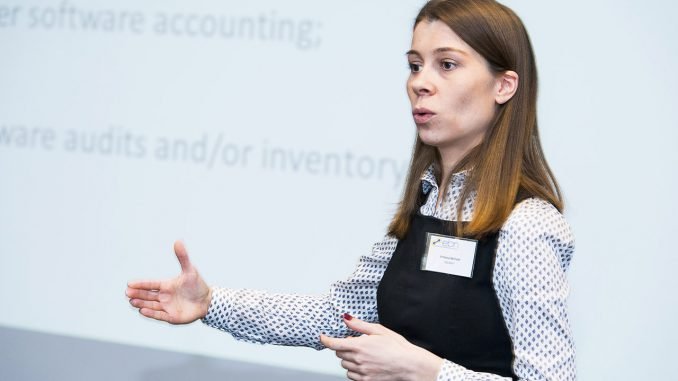
According to Seiliūtė, companies often lack proper software inventory. She laid out in some detail how authorities often prefer targeting businesses, from which stiff fines can be collected. This is especially true in Lithuania, where the State Tax Inspectorate uses law enforcement extensively. The fines often run in the thousands of Euros, confiscation of computers, and legal costs that could have easily been avoided.
Seiliūtė said that even IT managers, who are often very “sure of themselves,” are shocked to discover how much of our personal data is floating around on the Internet, out in public. “Around the world, there is a strong and consistent correlation between unlicensed software use and malware encounters,” said Seiliūtė. “Thus, it is important to understand for businesses that usage of unlicensed software is not only an issue of copyrights or an issue of potential legal liability to companies for copyrights infringements.”
After the presentation, we asked Ms. Seiliūtė a few questions about compliance with IP laws in Lithuania.
LT: How does Lithuania compare to other EU and neighbouring countries in ensuring compliance with IP laws?
Ernesta Seiliūtė: In general and in our view, Lithuania has quite strong legal regulation, as Lithuania has implemented international treaties protecting IP rights (IPR). There is also a rather strong court enforcement, particularly for software protection. However, the current regulation in Lithuania does not apply to IPR infringements related to the internet and this is an issue for other countries as well.
In our view and based on our practice, if the right holder is proactive and cooperative, they receive sufficient support from local Law Enforcement Agencies and that helps to ensure compliance with IP laws.
LT: How much is pirated software used in Lithuania?
Seiliūtė: According to the 2014 BSA Global Software Survey, 53% of software used in Lithuania is unlicensed, meaning that almost every second Lithuanian PC runs unlicensed software. It is a very similar situation in neighbouring countries with Estonia (47% use of unlicensed software), Latvia (53%) and Poland (51%). Other neighbouring countries like Russia have 62% unlicensed software; in Belarus, it is even worse at 86%. As it is a bi-annual survey, the new BSA survey will come out mid-2016, and we expect some improvement at least for Lithuania.
LT: Is there a ‘whistle-blower’ site or telephone line set up in Lithuania to report pirated software? How much was it used in recent years?
Seiliūtė: Yes, there is a website: www.e-police.lt. The local software association has a site, also with good information: www.vpi-a.lt.
The telephone line to report use of unlicensed software is the general “trust” telephone line used by local police. There is also a possibility to provide reports to police via SMS.
Most often, informers use the websites to report unlicensed software. These sites all guarantee anonymity to informants. Information about informants themselves may only be disclosed in cases established by local laws such as a person providing intentionally false information.
It probably does not come as a surprise that ex-employees are the most common source of information about the use of unlicensed or inappropriate use of software by small and medium business.
LT: What do you suggest as the most important steps in advising business to ensure compliance using legal software?
Seiliūtė: In our view, the most important step is software asset management. The International Organization for Standardization (ISO) and the International Electrotechnical Commission (IEC) published a standard specifically on software asset management (SAM), which is designed to help companies ensure they properly manage their software in a way that ensures continuous compliance, minimizes exposure to risks, and maximizes the benefit companies derive from this critically important asset.
SAM recommends four key steps to implementing ISO-aligned management of software: First, conduct an assessment, that is, gather and maintain reliable and consistent data that you can use to assess whether or not you are properly licensed. Second, it is important that businesses align licenses with their business needs. They must ensure that they match their current and future business needs to the right licensing model. Thirdly, it is important to establish policies and procedures, to ensure that SAM plays a role in the IT lifecycle in their business. For an ISO-aligned SAM to be effective, the practices need to support the business’s IT infrastructure and management needs to support the SAM process. Last point is that the Software Asset Management is a well-integrated part within the Business. A business needs to ensure that SAM is integrated and supports the entire business.

Be the first to comment